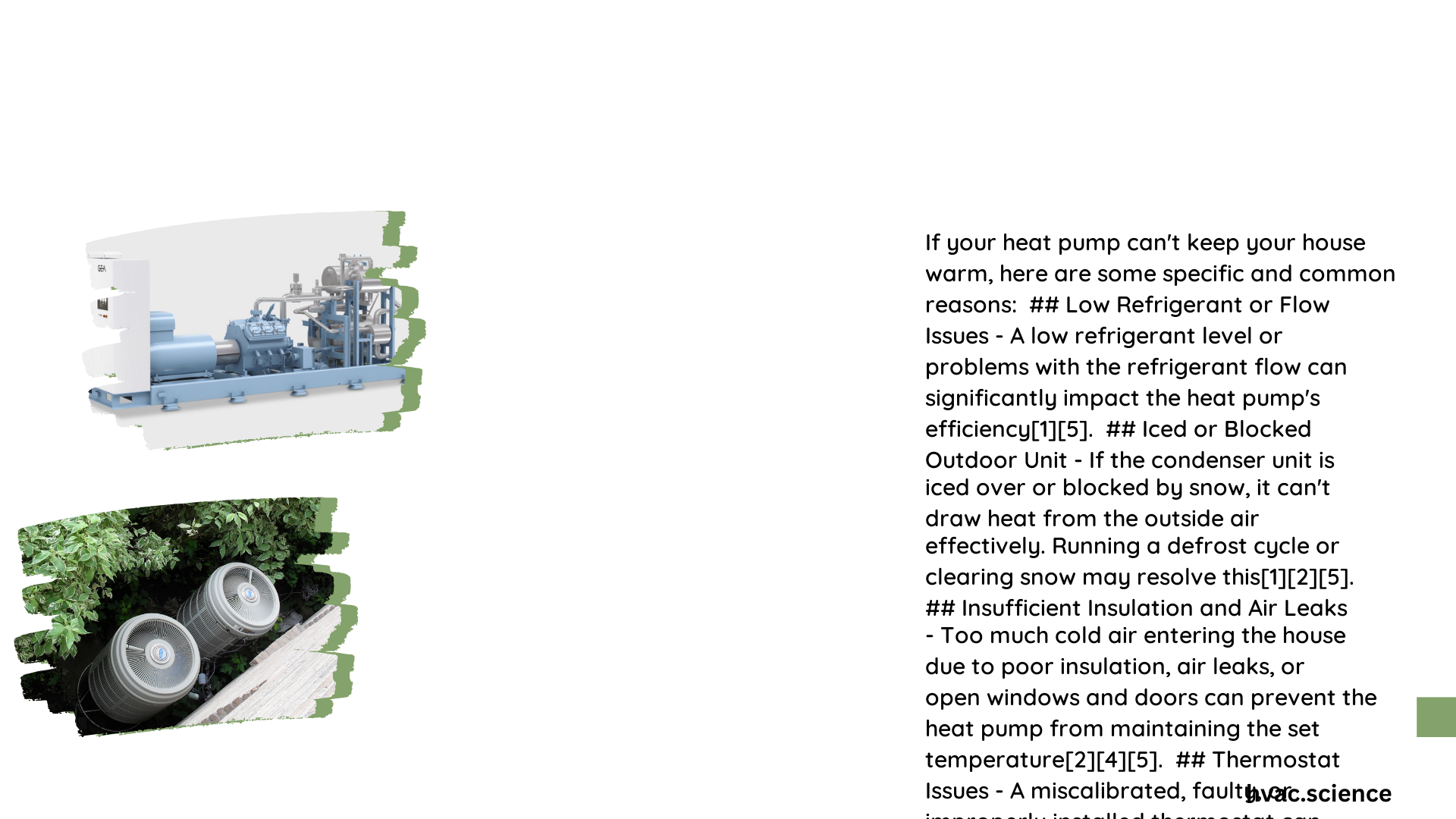A heat pump that can’t keep a house warm is a common issue faced by homeowners. This problem can stem from various factors, including insufficient heating capacity, extreme outdoor temperatures, low refrigerant levels, dirty air filters, thermostat issues, or electrical problems. Understanding these causes and implementing appropriate solutions can help restore your heat pump’s efficiency and ensure a comfortable indoor environment.
Why Is My Heat Pump Not Keeping My House Warm?
The primary reasons for a heat pump failing to keep a house warm include:
- Undersized heat pump for the home’s heating needs
- Extremely low outdoor temperatures affecting efficiency
- Low refrigerant levels
- Dirty or clogged air filters
- Thermostat problems
- Electrical issues
- Malfunctioning reversing valve
Let’s explore each of these issues in detail and discuss potential solutions.
What Are the Signs of an Undersized Heat Pump?

An undersized heat pump will struggle to maintain the desired temperature, especially during colder weather. Signs include:
- Constant running without reaching the set temperature
- Uneven heating throughout the house
- Higher energy bills due to inefficient operation
To address this issue, consult with an HVAC professional to determine if your heat pump’s BTU output matches your home’s heating requirements.
How Does Outdoor Temperature Affect Heat Pump Performance?
Heat pumps become less efficient in extremely low temperatures, typically below 40°F (4°C). At these temperatures, the heat pump may not be able to absorb enough heat from the outside air to maintain a comfortable indoor temperature.
Solutions:
– Install a dual-fuel system with a backup heat source for extremely cold days
– Use supplemental heating methods during the coldest periods
– Consider upgrading to a more efficient heat pump model designed for colder climates
What Are the Consequences of Low Refrigerant Levels?
Low refrigerant levels can significantly impact a heat pump’s ability to transfer heat efficiently. Signs of low refrigerant include:
- Frozen coil on the outdoor unit
- Hissing sounds from the heat pump
- Liquid pooling near the outdoor unit
If you suspect low refrigerant levels, contact an HVAC professional immediately. They can check the levels and recharge the system if necessary.
How Do Dirty Air Filters Affect Heat Pump Performance?
Dirty or clogged air filters can reduce airflow, making the heat pump less efficient and potentially causing it to stop heating altogether. To prevent this issue:
- Check air filters monthly
- Clean or replace filters as needed (typically every 1-3 months)
- Use high-quality filters appropriate for your system
What Thermostat Issues Can Cause Heating Problems?
Thermostat problems that can prevent proper heating include:
- Incorrect settings
- Dead batteries
- Faulty wiring
- Calibration issues
To troubleshoot thermostat problems:
- Verify the thermostat is set to ‘heat’ mode
- Ensure the desired temperature is higher than the current room temperature
- Replace batteries if necessary
- Check for loose wires or other visible issues
- Consider upgrading to a programmable or smart thermostat for better control
How Can Electrical Issues Affect Heat Pump Operation?
Electrical problems can disrupt heat pump operation. Common issues include:
- Tripped circuit breakers
- Blown fuses
- Faulty capacitors or contactors
To address electrical issues:
- Check the circuit breaker panel and reset any tripped breakers
- Replace blown fuses
- Ensure the indoor unit power switch and outdoor unit disconnect switch are on
- Contact an HVAC professional for more complex electrical problems
What Is a Reversing Valve and How Can It Cause Heating Issues?
The reversing valve is responsible for switching the heat pump between heating and cooling modes. A malfunctioning reversing valve can prevent the heat pump from heating properly.
Signs of a faulty reversing valve:
– Heat pump works in cooling mode but not in heating mode
– Inconsistent heating performance
If you suspect a reversing valve issue, contact an HVAC professional for diagnosis and repair.
What Are the Costs Associated with Heat Pump Repairs?
Here’s a breakdown of potential repair costs:
| Repair Type | Estimated Cost Range |
|---|---|
| Refrigerant Recharge | $100 – $500 |
| Air Filter Replacement | $10 – $50 |
| Thermostat Replacement | $100 – $500 |
| Electrical Component Replacement | $100 – $500 |
| Capacitor Replacement | $50 – $200 |
| Contactor Replacement | $50 – $200 |
| Reversing Valve Replacement | $200 – $1,000 |
| Compressor Replacement | $500 – $2,000+ |
How Long Do Heat Pump Repairs Typically Take?
The time required for heat pump repairs varies depending on the issue:
- Simple fixes (e.g., changing filters, resetting breakers): 30 minutes to 1 hour
- Refrigerant recharge: 1 to 3 hours
- Thermostat replacement: 1 to 2 hours
- Electrical component replacement: 1 to 3 hours
- Compressor or reversing valve replacement: 3 to 6 hours or more
By understanding these common issues and their solutions, you can better maintain your heat pump and ensure it keeps your house warm efficiently. Regular maintenance and prompt attention to problems can help extend the life of your heat pump and maintain optimal performance.
References:
1. Why Is My Heat Pump Not Heating? HVAC Tech Explains – Buckeye Heat
2. Common Reasons for Your Heat Pump Not Heating – Trane®
3. Why Is My Heat Pump Not Heating? – ARS/Rescue Rooter
